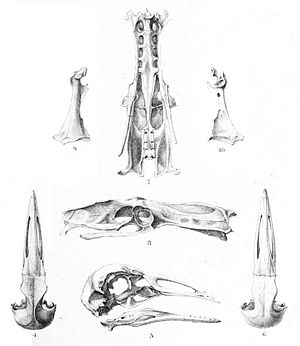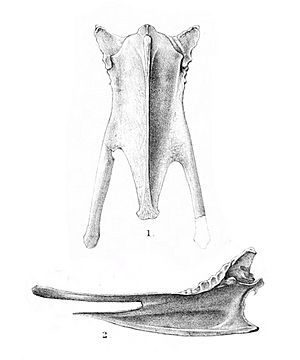Chatham coot facts for kids
Quick facts for kids Chatham cootTemporal range: Early Holocene
|
|
|---|---|
 |
|
| Views of skull, coracoid and pelvis | |
| Scientific classification | |
| Genus: |
Fulica
|
| Species: |
chathamensis
|
| Synonyms | |
|
|
The Chatham coot (Fulica chathamensis) was a special bird that lived only on the Chatham Islands in New Zealand. It is now extinct, meaning it no longer exists. This bird belonged to the rail family, called Rallidae.
Scientists first learned about the Chatham coot from old bones found in 1892. A Scottish explorer and bird expert named Henry Forbes studied these bones. He was working at the Canterbury Museum at that time.
Contents
What was the Chatham Coot?
The Chatham coot was a large bird, a bit bigger than the New Zealand coot. It was about 40 centimeters (16 inches) long and weighed around 1.9 kilograms (4.2 pounds). It looked like other coots, but it had a very long neck, long legs, and long toes. Scientists think it could probably fly.
Where did it live?
This coot likely lived in the salty water of Te Whanga Lagoon on Chatham Island. We know this because its bones show it had large salt glands. These glands help birds get rid of extra salt from their bodies.
How do we know about it?
The first bones of the Chatham coot were found in sand dunes on Chatham Island in 1892. Since then, many more bones have been discovered. Some bones were found in old Moriori rubbish piles, called middens. This shows that the Chatham coot was often hunted and eaten by people.
Why did the Chatham Coot disappear?
The main reason the Chatham coot became extinct was likely over-hunting. People hunted too many of them for food. This made it hard for the birds to survive and have enough babies to keep their population going.


